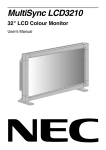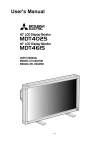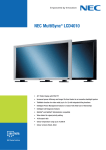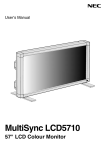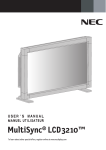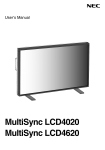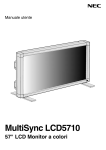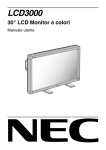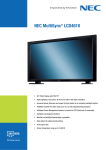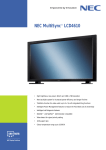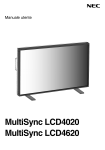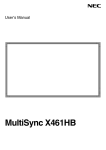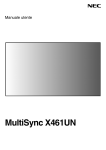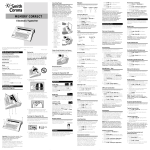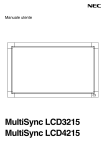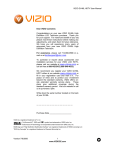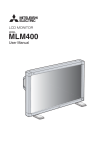Download User`s Manual
Transcript
MultiSync LCD4010 40" LCD Colour Monitor MultiSync LCD4610 46" LCD Colour Monitor User’s Manual Index Declaration of conformity ............................................................................................................................. English-1 Important Information ................................................................................................................................... English-2 Warning, Caution ......................................................................................................................................... English-2 Declaration ................................................................................................................................................... English-2 Safety Precautions, Maintenance & Recommended Use ............................................................................ English-3 Contents ....................................................................................................................................................... English-4 Parts Name and Functions .......................................................................................................................... English-5 Control Panel ...................................................................................................................................... English-5 Terminal Panel .................................................................................................................................... English-6 Wireless Remote Control ................................................................................................................... English-7 Operating Range for the Remote Control ........................................................................................... English-8 Handling the remote control ........................................................................................................... English-8 Setup Procedure .......................................................................................................................................... English-9 How to Mount and Attach Options to the LCD Monitor ................................................................................ English-11 Connections ................................................................................................................................................. English-12 Wiring Diagram ................................................................................................................................... English-12 Connecting a Personal Computer ...................................................................................................... English-13 Connect the LCD Monitor to a Personal Computer ........................................................................ English-13 Connecting to a Macintosh Computer ................................................................................................ English-14 Connect the LCD Monitor to Macintosh ......................................................................................... English-14 Connecting with Digital Interface Equipment ...................................................................................... English-15 Connect the LCD Monitor to a Computer with a Digital Output ...................................................... English-15 Connecting a DVD Player with component out ................................................................................... English-16 Connect the LCD Monitor to a DVD Player .................................................................................... English-16 Connecting to a Stereo Amplifier ........................................................................................................ English-17 Connect the LCD Monitor to a Stereo Amplifier ............................................................................. English-17 Basic Operation ........................................................................................................................................... English-18 Power ON and OFF Modes ................................................................................................................ English-18 Power Indicator ................................................................................................................................... English-19 Using Power Management ................................................................................................................. English-19 Selecting a video source .................................................................................................................... English-19 Picture Size ........................................................................................................................................ English-19 Picture Mode ...................................................................................................................................... English-19 Information OSM ................................................................................................................................ English-19 OSM (On-Screen-Manager) Controls .......................................................................................................... English-20 PICTURE ............................................................................................................................................ English-20 SCREEN ............................................................................................................................................ English-21 AUDIO ................................................................................................................................................ English-22 PICTURE IN PICTURE ...................................................................................................................... English-23 CONFIGURATION 1 ........................................................................................................................... English-23 CONFIGURATION 2 ........................................................................................................................... English-24 ADVANCED OPTION ......................................................................................................................... English-26 Controlling the LCD monitor via RS-232C Remote Control ......................................................................... English-30 Features ....................................................................................................................................................... English-32 Troubleshooting ............................................................................................................................................ English-33 Specifications ............................................................................................................................................... English-34 Pin Assignment ............................................................................................................................................ English-36 This device complies with Part 15 of FCC Rules. Operation is subject to the following two conditions. (1) This device may not cause harmful interference, and (2) this device must accept any interference received, including interference that may cause undesired operation. U.S. Responsible Party: Address: Tel. No.: NEC-Mitsubishi Electronics Display of America, Inc. 500 Park Boulevard, Suite 1100 Itasca, Illinois 60143 (630) 467-3000 Type of Product: Computer Monitor Equipment Classification: Class B Peripheral Model: MultiSync LCD4010 (L404G6) / MultiSync LCD4610 (L464G7) We hereby declare that the equipment specified above conforms to the technical standards as specified in the FCC Rules. Windows is a registered trademark of Microsoft Corporation. NEC is a registered trademark of NEC Corporation. OmniColor is a registered trademark of NEC-Mitsubishi Electronics Display Europe GmbH in the countries of EU and Switzerland. All other brands and product names are trademarks or registered trademarks of their respective owners. Canadian Department of Communications Compliance Statement DOC: This Class B digital apparatus meets all requirements of the Canadian Interference-Causing Equipment Regulations. C-UL: Bears the C-UL Mark and is in compliance with Canadian Safety Regulations according to CAN/CSA C22.2 No. 60950-1. FCC Information 1. Use the attached specified cables with the MultiSync LCD4010 (L404G6) / MultiSync LCD4610 (L464G7) colour monitor so as not to interfere with radio and television reception. (1) Please use the supplied power cord or equivalent to ensure FCC compliance. (2) Please use the supplied shielded video signal cable, 15-pin mini D-SUB to 15-pin mini D-SUB. (3) Please attach the ferrite cores on the Audio Cable. Please see page 12 of this manual. 2. This equipment has been tested and found to comply with the limits for a Class B digital device, pursuant to part 15 of the FCC Rules. These limits are designed to provide reasonable protection against harmful interference in a residential installation. This equipment generates, uses, and can radiate radio frequency energy, and, if not installed and used in accordance with the instructions, may cause harmful interference to radio communications. However, there is no guarantee that interference will not occur in a particular installation. If this equipment does cause harmful interference to radio or television reception, which can be determined by turning the equipment off and on, the user is encouraged to try to correct the interference by one or more of the following measures: • Reorient or relocate the receiving antenna. • Increase the separation between the equipment and receiver. • Connect the equipment into an outlet on a circuit different from that to which the receiver is connected. • Consult your dealer or an experienced radio/TV technician for help. If necessary, the user should contact the dealer or an experienced radio/television technician for additional suggestions. The user may find the following booklet, prepared by the Federal Communications Commission, helpful: “How to Identify and Resolve RadioTV Interference Problems.” This booklet is available from the U.S. Government Printing Office, Washington, D.C., 20402, Stock No. 004-000-00345-4. English-1 English DECLARATION OF CONFORMITY Important Information WARNING TO PREVENT FIRE OR SHOCK HAZARDS, DO NOT EXPOSE THIS UNIT TO RAIN OR MOISTURE. ALSO, DO NOT USE THIS UNIT’S POLARIZED PLUG WITH AN EXTENSION CORD RECEPTACLE OR OTHER OUTLETS UNLESS THE PRONGS CAN BE FULLY INSERTED. REFRAIN FROM OPENING THE CABINET AS THERE ARE HIGH VOLTAGE COMPONENTS INSIDE. REFER SERVICING TO QUALIFIED SERVICE PERSONNEL. CAUTION CAUTION: TO REDUCE THE RISK OF ELECTRIC SHOCK, MAKE SURE POWER CORD IS UNPLUGGED FROM WALL SOCKET. TO FULLY DISENGAGE THE POWER TO THE UNIT, PLEASE DISCONNECT THE POWER CORD FROM THE AC OUTLET. DO NOT REMOVE COVER (OR BACK). NO USER SERVICEABLE PARTS INSIDE. REFER SERVICING TO QUALIFIED SERVICE PERSONNEL. This symbol warns user that uninsulated voltage within the unit may have sufficient magnitude to cause electric shock. Therefore, it is dangerous to make any kind of contact with any part inside this unit. This symbol alerts the user that important literature concerning the operation and maintenance of this unit has been included. Therefore, it should be read carefully in order to avoid any problems. Declaration Declaration of the Manufacturer We hereby certify that the colour monitor MultiSync LCD4010 (L404G6) / MultiSync LCD4610 (L464G7) is in compliance with and marked with Council Directive 73/23/EEC: – EN 60950-1 Council Directive 89/336/EEC: – EN 55022 – EN 61000-3-2 – EN 61000-3-3 – EN 55024 NEC-Mitsubishi Electric Visual Systems Corporation 4-13-23, Shibaura, Minato-Ku Tokyo 108-0023, Japan English-2 FOR OPTIMUM PERFORMANCE, PLEASE NOTE THE FOLLOWING WHEN SETTING UP AND USING THE MULTISYNC LCD4010 / MULTISYNC LCD4610 LCD COLOUR MONITOR: • • • Immediately unplug your monitor from the wall outlet and refer servicing to qualified service personnel under the following conditions: DO NOT OPEN THE MONITOR. There are no user serviceable parts inside and opening or removing covers may expose you to dangerous shock hazards or other risks. Refer all servicing to qualified service personnel. Do not spill any liquids into the cabinet or use your monitor near water. Do not insert objects of any kind into the cabinet slots, as they may touch dangerous voltage points, which can be harmful or fatal or may cause electric shock, fire or equipment failure. • Do not place any heavy objects on the power cord. Damage to the cord may cause shock or fire. • Do not place this product on a sloping or unstable cart, stand or table, as the monitor may fall, causing serious damage to the monitor. • When the power supply cord or plug is damaged. • If liquid has been spilled, or objects have fallen into the monitor. • If the monitor has been exposed to rain or water. • If the monitor has been dropped or the cabinet damaged. • If the monitor does not operate normally by following operating instructions. Recommended Use • For optimum performance, allow 20 minutes for warm-up. • Rest your eyes periodically by focusing on an object at least 5 feet away. Blink often. • Position the monitor at a 90° angle to windows and other light sources to minimize glare and reflections. • Clean the LCD monitor surface with a lint-free, non-abrasive cloth. Avoid using any cleaning solution or glass cleaner! • Adjust the monitor’s brightness and contrast controls to enhance readability. • When operating the MultiSync LCD4010 / MultiSync LCD4610 LCD monitor with its AC 220-240V power supply in Europe, use a power supply cord provided with the monitor. • In UK, use a BS-approved power cord with molded plug having a black (13A) fuse installed for use with this monitor. If a power cord is not supplied with this monitor, please contact your supplier. • Avoid displaying fixed patterns on the monitor for long periods of time to avoid image persistence (after image effects). • Get regular eye checkups. • When operating the MultiSync LCD4010 / MultiSync LCD4610 with a 220-240V AC power source in Australia, use the power cord provided with the monitor. If a power cord is not supplied with this equipment, please contact your supplier. • The lamp of backlight contains mercury. Please handle it appropriately in case of disposal. • For all other cases, use a power cord that matches the AC voltage of the power outlet and has been approved by and complies with the safety standard of your particular country. To realize the maximum ergonomic benefits, we recommend the following: • Do not place any objects onto the monitor and do not use the monitor outdoors. • The inside of the fluorescent tube located within the LCD monitor contains mercury. Please follow the bylaws or rules of your municipality to dispose of the tube properly. • Do not bend power cord. • Do not use monitor in high temperature, humid, dusty, or oily areas. • If glass is broken handle with care. • Do not cover vent on monitor. • If monitor or glass is broken, do not come in contact with the liquid crystal and handle with care. • Allow adequate ventilation around the monitor, so that heat can properly dissipate. Do not block ventilated openings or place the monitor near a radiator or other heat sources. Do not put anything on top of the monitor. • The power cable connector is the primary means of detaching the system from the power supply. The monitor should be installed close to a power outlet, which is easily accessible. • Handle with care when transporting. Save packaging for transporting. • Please clean the holes of back cabinet to reject dirt and dust at least once a year because of set reliability. • If using the cooling fan continuously, it’s recommended to wipe holes a minimum of once a month. Ergonomics • Use the preset Size and Position controls with standard signals. • Use the preset Colour Setting. • Use non-interlaced signals. • Do not use primary colour blue on a dark background, as it is difficult to see and may produce eye fatigue due to insufficient contrast. English-3 English Safety Precautions, Maintenance & Recommended Use Contents Your new MultiSync LCD4010 / MultiSync LCD4610 monitor box* should contain the following: • LCD monitor • Band x 2 • Power Cord (3m) • Ferrite Core x 2 • Video Signal Cable — SC-B113 (4m) • Speaker Plug x 1set (Required for optional Loudspeakers) • User’s Manual • Stand for the Independence x 2 • Wireless Remote Control and AA Batteries • Thumbscrew for stand x 2 • Clamper x 3 • Main switch cover • Screw (M4 x 8) x 4 • CD-ROM Thumbscrew for stand x 2 Stand for the Independence x 2 Power Cord Main switch cover Video Signal Cable (D-SUB to D-SUB Cable) Clamper x 3 Screw (M4 x 8) x 4 Speaker Plug x 1set (Required for optional Loudspeakers) (Attached on external speaker terminal) Ferrite Core x 2 CD-ROM User’s Manual Wireless Remote Control and AA Batteries * Install the stands at the time of unpacking if the display will be used with the stand. * Remember to save your original box and packing material to transport or ship the monitor. The following components are prepared as option. • External Speaker Unit English-4 Band x 2 English Parts Name and Functions Control Panel 9 EXIT INPUT MUTE 10 Button Location EXIT INPUT MUTE OFF 8 7 6 5 4 3 2 ON 1 1 POWER button ( ) 7 DOWN ( ) button Switches the power on/off. See also page 18. Activates the OSM menu when the OSM menu is turned-off. Acts as button to move the highlighted area down to select the adjustment with OSM menu. 2 MUTE button Switches the audio mute ON/OFF. 8 EXIT button 3 INPUT button Acts as SET button within OSM menu. (Toggle switches between [RGB1], [RGB2], [RGB3], [DVD/HD], [VIDEO] or [VIDEO<S>]). [VIDEO<S>] is enabled by selecting the “SEPARATE” mode in the OSM or by having the “S-VIDEO” cable connected with the “S-VIDEO” signal present and selecting “PRIORITY” MODE. See page 26. Activates the OSM menu when the OSM menu is turned-off. Acts as EXIT button to move to previous menu with OSM menu. 9 Remote control sensor and Power Indicator Acts as (+) button to increase the adjustment with OSM menu. Increases the audio output level when the OSM menu is turned off. Receives the signal from the remote control (when using the wireless remote control). See also page 8. Glows green when the LCD monitor is in active and glows red when the LCD monitor is in POWER OFF mode. When the LCD monitor is in POWER SAVE mode, it will glow both green and red. When SCHEDULE is enabled, it will blink green. See page 19. In the case of where a failure is detected, it will blink red. 5 MINUS (-) button 10 Main Power Switch Acts as (-) button to decrease the adjustment with OSM menu. Decreases the audio output level when the OSM menu is turned off. On/off Switch to turn main power on/off. 4 PLUS (+) button 6 UP ( ) button Activates the OSM menu when the OSM menu is turned-off. Acts as button to move the highlighted area up to select the adjustment with OSM menu. Control Key Lock Mode This control completely locks out access to all Control Key functions. To activate the control key lock function, press both of “ ” and “ ” and hold down simultaneously for more than 3 seconds. To resume back to user mode, press both of “ ” and “ ” and hold simultaneously for more than 3 seconds. English-5 Terminal Panel 1 AC IN connector 7 AUDIO IN 1, 2, 3 Connects with the supplied power cord. To input audio signal from external equipment such as a computer, VCR or DVD player. 2 RGB 1 IN (DVI-D) 8 AUDIO OUT To input digital RGB signals from a computer or HDTV device having a digital RGB output. To output the audio signal from the AUDIO IN 1, 2 and 3 jack. * This connector does not support analog input. 9 VIDEO INPUT/OUTPUT CONNECTOR 3 RGB 2 IN (mini D-Sub 15 pin) To input analog RGB signals from a personal computer or other RGB equipment. 4 RGB 3 [R, G, B, H, V] (BNC) IN connector: To input analog RGB signals or signals from other RGB equipment. This is also to connect equipment such as a DVD player and HDTV laser disk player. A Sync-on-Green signal can be connected to the G connector. 5 RGB OUT connector (BNC) VIDEO IN connector (BNC and RCA): To input a composite video signal. BNC and RCA connectors are not available at the same time. (Use only one input). VIDEO OUT connector (BNC): To output the composite video signal from the VIDEO IN connector. S-VIDEO IN connector (DIN 4 pin): To input the S-video (Y/C separate signal). See page 26, S-VIDEO MODE SETTING. 10 EXTERNAL CONTROL (mini D-Sub 9 pin) IN connector: Use when operating the LCD monitor from the RGB equipment like a computer. Out connector: To connect multiple MultiSync LCD4010 / MultiSync LCD4610. To output the signal from RGB 3. 11 EXTERNAL SPEAKER TERMINAL To output the audio signal from AUDIO 1, 2 or 3 jack. 6 DVD/HD connector (BNC) Connecting equipment such as a DVD player, HDTV device, or Laser disc player. English-6 6 MUTE button To switch the mute function on/off. 7 VOLUME UP button Increases the audio output level. 8 VOLUME DOWN button Decreases the audio output level. 9 PIP (Picture In Picture) button ON/OFF button: Toggle switches between PIP, POP, side-by-side (aspect) and side-by-side (full). See page 23. INPUT button: Selects the “picture in picture” input signal. CHANGE button: Replaces to the main picture and sub picture. 10 STILL button ON/OFF button: To switch the still picture mode on/off. CAPTURE button: Captures the new picture. Note: Still does not work when pixel clock is greater than 108MHz. 11 DISPLAY button To switch the information OSM on/off. See page 19. 12 AUTO SETUP button To enter the auto setup menu. See page 23. 13 MENU button To switch the menu mode on/off. 14 UP button Acts as button to move the highlighted area up to select the adjustment with OSM menu. Small screen which adjusted “PIP” mode moves up. 1 POWER button Switches the power on/off. * If Power Indicator is not glowing, then no controls will work. 15 DOWN button 2 INPUT button Acts as button to move the highlighted area down to select the adjustment with OSM menu. Small screen which adjusted “PIP” mode moves down. Selects from input signal, [RGB1], [RGB2], [RGB3], [DVD/HD], [VIDEO] and [VIDEO<S>]. [VIDEO<S>] is enabled by selecting the “SEPARATE” mode in the OSM or by having the “S-VIDEO” cable connected with the “S-VIDEO” signal present and selecting “PRIORITY” MODE. See page 26. 16 MINUS button decrease Acts as (-) button to decrease the adjustment with OSM menu. Small screen which adjusted “PIP” mode moves left. 3 AUDIO INPUT button 17 PLUS button increase Selects from input audio signal, [AUDIO1], [AUDIO2], [AUDIO3]. Acts as (+) button to increase the adjustment with OSM menu. Small screen which adjusted “PIP” mode moves right. 4 SIZE button 18 SET button Selects picture size, [FULL], [NORMAL], [WIDE] and [ZOOM]. See page 19. Acts as SET button with OSM menu. 5 PICTURE MODE button 19 EXIT button Selects from picture mode, [HIGHBRIGHT], [STANDARD], [sRGB], [CINEMA]. See page 19. Turn to previous menu with OSM menu. HIGHBRIGHT: for moving images such as DVD STANDARD: for images sRGB: for text based images CINEMA: for movies. English-7 English Wireless Remote Control Operating Range for the Remote Control Point the top of the remote control toward the LCD monitor’s remote sensor during button operation. Handling the remote control Use the remote control within a distance of about 7 m/23 ft. from the front of the LCD monitor’s remote control sensor and at a horizontal and vertical angle of within 30° within a distance of about 3 m/10 ft. * Do not subject to strong shock. * Do not allow water or other liquid to splash the remote control. If the remote control gets wet, wipe it dry immediately. * Avoid exposure to heat and steam. * Other than to install the batteries, do not open the remote control. Caution: Important, the remote control system may not function when direct sunlight or strong illumination strikes the remote control sensor of the LCD monitor, or when there is an object in the path. English-8 1. Determine the installation location 3. Connect external equipment (See pages 12-17) CAUTION: DO NOT ATTEMPT TO INSTALL THE LCD MONITOR BY YOURSELF. Installing your LCD display must be done by a qualified technician. Contact your dealer for more information. CAUTION: MOVING OR INSTALLING THE LCD MONITOR MUST BE DONE BY TWO OR MORE PEOPLE. Failure to follow this caution may result in injury if the LCD monitor falls. CAUTION: Do not mount or operate the display upside down, face up, or face down. CAUTION: This LCD has a temperature sensor and cooling fan. If the LCD becomes too hot, the cooling fan will turn on automatically. If the LCD becomes overheated and the cooling fan is running, the “Caution” menu will appear. If the “Caution” menu appears, discontinue use and allow the unit to cool. When the LCD monitor is used in an enclosure or with protection on LCD surface, please check the inside temperature of monitor by “HEAT STATUS” (See page 28). The temperature is too hot than normal condition, please set “cooling fan” to ON on SCREEN SAVER function (See page 24). • To protect the connected equipment, turn off the main power before making connections. • Refer to your equipment user manual. 4. Connect the supplied power cord • The power outlet socket should be installed as near to the equipment as possible, and should be easily accessible. • Fully insert the prongs into the power outlet socket. Loose connection may cause noise. • Please fix the power cord by attaching the screw and clamper. NOTE: Please refer to “Safety Precautions, Maintenance & Recommended Use” section of this manual for proper selection of AC power cord. Screw Clamper IMPORTANT: Lay the protective sheet, which was wrapped around the LCD monitor when it was packaged, beneath the LCD monitor so as not to scratch the panel. 2. Install the remote control batteries The remote control is powered by 1.5V AA batteries. To install or replace batteries: Screw hole for clamper 1. Press and slide to open the cover. 2. Align the batteries according to the (+) and (–) indications inside the case. 3. Replace the cover. 5. Switch on the power of all attached external equipment When connected with a computer, switch on the power of the computer first. CAUTION: Incorrect use of batteries can result in leaks or bursting. 6. Operate the attached external equipment Display the signal on the external equipment you wish. Be careful especially about the following points. • Place “AA” size batteries matching the + and - signs on each battery to the + and - signs of the battery compartment. • Don’t mix battery types. • Don’t combine new batteries with used ones. • 7. Adjust the sound Make adjustments when adjustment of the volume is required. 8. Adjust the screen (See pages 20-28) It causes shorter battery life or leakage of batteries. Make adjustments when adjustment of the screen display position or distortion is required. Remove dead batteries immediately to prevent battery liquid from leaking into the battery compartment. 9. Adjust the image (See pages 20-28) Don’t touch exposed battery acid, it cause damage to your skin. Make adjustments when picture adjustment such as the brightness or contrast is required. NOTE: If you do not intend to use the Remote Control for a long period, remove the batteries. English-9 English Setup Procedure 10. Recommended Adjustment To reduce the risk of “image persistence”, please adjust the following items based on the application being used. “SCREEN SAVER” (See page 24), “SIDE BORDER COLOR” (See page 24), “DATE & TIME” (See page 28), “SCHEDULE” (See page 28). 11. When the monitor is installed in the portrait position • Remove the stands (feet). • Left edge should be the upper edge from front view. 12. Installing and removing stand Speaker terminal How to install stand 1. Please turn monitor off. 2. Place stand onto monitor with the long ends of the feet in front of the monitor. 3. After inserting stand in guide block, fasten thumbscrews on both sides of the monitor. How to remove the stand 1. Spread the protective sheet on the flat surface, such as a desk. How to use the attached speaker plug Standard cable 2. Place monitor on the protective sheet. Speaker plug 3. Remove thumbscrews with a screwdriver or with your fingers and place them in a safe place for reuse. Thumbscrews Striped wire of a standard cable is put into the speaker plug with pushing lever, like a current connector. Stand NOTE: Place stand onto monitor so that the long end of the feet are in the front. Fixed cable and speaker plug. 13. When using external speakers We recommend to using the option speakers designed for the MultiSync LCD4010 / MultiSync LCD4610. The external speaker terminals of the MultiSync LCD4010 / MultiSync LCD4610 may be connectable with the speaker plug of a mainframe sound speaker. It this case, please exchange the lead connector of a mainframe sound speaker for an attached speaker plug. Insert the fixed cable and speaker plug to the speaker terminal. English-10 You can attach mounting accessories to the LCD monitor in one of the following two ways: 3. Ventilation Requirements for enclosure mounting 1. In the upright position To allow heat to disperse, leave space between surrounding objects as shown in the diagram below. 4. To avoid falling down Fasten the LCD monitor to wall using a cord or chain, which is sufficient to support the weight of the LCD monitor (approx. LCD4010: 27,5kg / LCD4610: 32,8kg). 250mm 2. Lay the screen face down Screw Holes Protective Sheet Cord or Chain Clamper Table Tabletop Stand Lay the protective sheet on a table, which was wrapped around the monitor when it was packaged, beneath the screen surface so as not to scratch the screen face. Screw Before moving the LCD monitor, the cord or chain should be removed. 5. To prevent the main power switch from being changed This device cannot be used or installed without the Tabletop Stand or other mounting accessory. Failure to follow correct mounting procedures could result in damage to the equipment or injury to the user or installer. Product warranty does not cover damage caused by improper installation. Failure to follow these recommendations could result in voiding your warranty. To prevent the ability to use the main power switch, please attach the main switch, which is enclosed as an accessory. NOTE: With the main power switch cover in place, the main power switch cannot be turned off. Remove main power switch cover in order to switch off the display. When using with other mounting accessory, it must be a VESA-compatible mounting method and the screws must be M6 of size and 10mm or longer of length under consideration of the thickness of the mounting method. (Recommended torque: 470 - 635N•cm). NEC recommends using mounting interface that comply with TÜV-GS and/or UL1678 standard in North America. Screw English-11 Main switch cover English How to Mount and Attach Options to the LCD Monitor Connections Before making connections: * First turn off the power of all the attached equipment and make connections. * Refer to the user manual included with each separate piece of equipment. Wiring Diagram LCD monitor Personal computer DVD player Personal computer VCR Equipment with digital interface Attaching the Ferrite Core LCD monitor (second monitor) Mounting Position of Ferrite Core Attach the Ferrite Core to PC Audio Cable. Use of the cable without mounting the ferrite core will result in the occurrence of noise. For PC Audio Cable 1 Open the ferrite core and clamp it on the PC Audio cable. 2 Close the ferrite core. Attach the two Ferrite Cores to the both ends of PC Audio Cable. Ferrite Core Ferrite Core Ferrite Core To AUDIO 1 of monitor To connector of PC Band English-12 Band Connecting your computer to your LCD monitor will enable you to display your computer’s screen image. Some video cards may not display an image correctly. Connect the LCD Monitor to a Personal Computer • To connect the RGB 2 IN connector (mini D-sub 15 pin) on the LCD monitor, use the supplied PC - Video RGB signal cable (mini D-sub 15 pin to mini D-sub 15 pin). • To connect the RGB 3 connector (BNC) on the LCD monitor, use a signal cable which is available separately (mini D-sub 15 pin to BNC x 5). Select RGB 3 from the INPUT button. When connecting one or more LCD monitors, use the RGB OUT connector (BNC). The AUDIO IN 1, 2 and 3 can be used for audio input. For connection, select AUDIO 1, 2 or 3 from the AUDIO INPUT button. LCD monitor To audio output To analog RGB output Mini D-sub 15 pin BNC x 5 Mini D-sub 15 pin • PC or IBM compatible BNC x 5 To RGB 3 DVD/HD IN BNC x 5 LCD monitor (second monitor) English-13 English Connecting a Personal Computer Connecting to a Macintosh Computer Connecting your Macintosh computer to your LCD monitor will enable you to display your computer’s screen image. Some video cards or drivers may not display images correctly. Connect the LCD Monitor to Macintosh • To connect the RGB 2 IN connector (mini D-sub 15 pin) on the LCD monitor, use the supplied PC - Video RGB signal cable (mini D-sub 15 pin to mini D-sub 15 pin). • To connect the RGB 3 IN connector (BNC) on the LCD monitor, use the signal cable available separately (mini D-sub 15 pin to BNC x 5). • If you use with a Macintosh PowerBook, set “Mirroring” to Off. Refer to your Macintosh’s owner’s manual for more information about your computer’s video output requirements and any special identification or configuring your monitor’s image and monitor may require. The AUDIO IN 1, 2 and 3 can be used for audio input. For connection, select AUDIO 1, 2 or 3 from the AUDIO INPUT button. LCD monitor To audio output To analog RGB output Mini D-sub 15 pin BNC x 5 Macintosh Mini D-sub 15 pin • BNC x 5 To RGB 3 DVD/HD IN BNC x 5 LCD monitor (second monitor) English-14 Connections can be made with equipment that is equipped with a digital interface compliant with the DVI (Digital Visual Interface) standard. Connect the LCD Monitor to a Computer with a Digital Output • The RGB 1 IN connector also accepts a DVI-D cable. • Input TMDS signals conforming to DVI standards. • To maintain display quality, use a cable with a quality prescribed by DVI standards. • The AUDIO IN 1, 2 and 3 can be used for audio input. For connection, select AUDIO 1, 2 or 3 from the AUDIO INPUT button. • Mode selection, see “DVI MODE” of page 25. LCD monitor To audio output To DVI output DVI-D connector DVI-D connector English-15 Equipment with a digital interface such as a personal computer with RGB output (TMDS) English Connecting with Digital Interface Equipment Connecting a DVD Player with component out Connecting your DVD player to your LCD monitor will enable you to display DVD video. Refer to your DVD player user’s manual for more information. Connect the LCD Monitor to a DVD Player • To connect the DVD/HD IN connector (BNC) on the LCD monitor, use a separately available BNC connector cable. You will need a BNC-to-RCA adapter to connect a DVD player with an RCA pin jack to the BNC connector cable (not provided). Some DVD players may have different connectors such as DVD/HD connector (Y, Cb/Pb and Cr/Pr). Select [DVD/HD] input mode from the INPUT button. The AUDIO IN 2 and 3 (both RCA) can be used for audio input. For connection, select [AUDIO 2] or [AUDIO 3] from the AUDIO INPUT button. To audio right output BNC x 3 To audio left output BNC-to-RCA adapter Mode selection, see “DVI MODE” of page 25. BNC x 3 To DVI output To DVD Component video output RCA • DVI-D connector English-16 LCD monitor You can connect your stereo amplifier to your LCD monitor. Refer to your amplifier owner’s manual for more information. Connect the LCD Monitor to a Stereo Amplifier • Turn on the LCD monitor and the amplifier only after all connections have been made. • Use an RCA cable to connect the AUDIO OUT connector (RCA) on the LCD monitor and the audio input on the amplifier. • Do not reverse the audio left and right jacks. • The AUDIO IN is used for audio input. • The AUDIO OUT jack outputs sound from the selected Audio input. LCD monitor To audio right output To audio left output VCR or Laser disc player RCA Amplifier RCA To audio right output To audio left output External speaker English-17 External speaker English Connecting to a Stereo Amplifier Basic Operation Power ON and OFF Modes The LCD monitor power indicator will turn green while powered on, or red when in off mode. The monitor can be powered on or off using the following three options: 1. Pressing the power button. Note: Before pressing the power button, be sure to turn on the Main Power Switch on the LCD monitor. Power Button 2. Using the remote control. Note: Before operating the remote control, be sure to turn on the Main Power Switch on the LCD monitor. 3. Pressing the Main Power Switch. Note: Main Power Switch English-18 When the Main Power Switch is used to power off the LCD, the remote control and the power button will not activate the on mode. Be sure to turn the Main Power Switch to the on mode before using these two options. Status Power ON Green Power OFF Red Power Standby when Red On “SCHEDULE” is enable Green Blinking Power Standby Diagnosis (Detecting failure) Red, Green Red Blinking ZOOM Image can be expanded beyond the active display area. The image which is outside of active diaplay area is not displayed. ZOOM * See troubleshooting on page 33 Using Power Management The LCD monitor follows the VESA approved DPM Power Management function. The power management function is an energy saving function that automatically reduces the power consumption of the display when the keyboard or the mouse has not been used for a fixed period. The power management feature on your new display has been set to the “ON” mode. This allows your display to enter a Power Saving Mode when no signal is applied. This could potentially increase the life and decrease the power consumption of the display. ZOOM Picture Mode RGB 1, 2, 3 HIGHBRIGHT STANDARD sRGB DVD/HD, VIDEO HIGHBRIGHT STANDARD CINEMA Information OSM RGB1, 2, 3 Selecting a video source RGB2 1024 x 768 48kHz 60Hz AUDIO : 1 SIZE : FULL To view a video source: ) Audio input mode Picture Size mode Use the input button to set [VIDEO]. Use the COLOR SYSTEM menu to set [AUTO], [NTSC], [PAL], [SECAM], [PAL60], [4.43NTSC], in according to your video format. DVD/HD Picture Size DVD/HD AUDIO : 3 SIZE : WIDE RGB 1, 2, 3 FULL ZOOM NORMAL DVD/HD, VIDEO FULL WIDE ZOOM Signal Type NORMAL SIZE Video Input mode Input signal Information Video Input mode Audio input mode Picture Size mode NORMAL Recommended Size VIDEO NORMAL VIDEO<S> NTSC AUDIO : 3 SIZE : NORMAL Video Input mode Input Signal Colour System mode Audio input mode Picture Size mode 4:3 ZOOM (DYNAMIC) PIP or POP FULL Squeeze Main:RGB2 Sub:VIDEO<S> RGB2 1024 x 768 48kHz 60Hz AUDIO : 1 VIDEO<S> NTSC SIZE : FULL WIDE Letter box English-19 Main picture Information ) Sub picture Information Main picture Information English NORMAL: Display by the inputed signal aspect ratio by PC signal, or display in 4:3 aspect ratio at DVD/HD or VIDEO signal. FULL: Display in entire screen. WIDE: Expand 16:9 letter box signal to entire screen. ZOOM (DYNAMIC): Expand 4:3 pictures to the entire screen with non-linearity. (Some around image will be cut by expansion.) Power Indicator OSM (On-Screen-Manager) Controls Press MENU button to open Main menu. Press UP or DOWN button to select sub-menu. Press SET button to decide. Press UP or DOWN, and PLUS or MINUS button to select function, or control which you like. Press SET button to decide. Press MENU or EXIT button to exit. Press UP or DOWN button to select. Press INPUT button to decide. Press UP or DOWN, and PLUS or MINUS button to select function, or control which you like. Press INPUT button to decide. Press EXIT button to exit. Remote Control Control Panel UP or DOWN button MAIN MENU PICTURE SCREEN AUDIO PIP CONFIGURATION 1 CONFIGURATION 2 ADVANCED OPTION OSM screen :SEL SET :NEXT EXIT :RETURN MENU :EXIT MENU INPUT button PICTURE PICTURE BRIGHTNESS BRIGHTNESS CONTRAST SHARPNESS BLACK LEVEL COLOR CONTROL COLOR TEMPERATURE PICTURE RESET BRIGHTNESS CONTRAST SHARPNESS BLACK LEVEL COLOR CONTROL COLOR TEMPERATURE PICTURE RESET 32 + -:ADJ EXIT :RETURN MENU :EXIT MENU :SEL SET :NEXT EXIT :RETURN MENU :EXIT MENU :SEL SET :NEXT EXIT :RETURN MENU :EXIT MENU Main-Menu MAIN MENU PICTURE SCREEN AUDIO PIP CONFIGURATION 1 CONFIGURATION 2 ADVANCED OPTION PICTURE :SEL SET :NEXT EXIT :RETURN MENU :EXIT MENU Sub-Menu Adjusts the overall image and background screen brightness. PICTURE BRIGHTNESS BRIGHTNESS CONTRAST SHARPNESS BLACK LEVEL COLOR CONTROL COLOR TEMPERATURE PICTURE RESET BRIGHTNESS 32 + -:ADJ EXIT :RETURN MENU :EXIT MENU :SEL SET :NEXT EXIT :RETURN MENU :EXIT MENU PICTURE CONTRAST BRIGHTNESS CONTRAST SHARPNESS BLACK LEVEL COLOR CONTROL COLOR TEMPERATURE PICTURE RESET CONTRAST 32 + -:ADJ EXIT :RETURN MENU :EXIT MENU :SEL SET :NEXT EXIT :RETURN MENU :EXIT MENU PICTURE SHARPNESS BRIGHTNESS CONTRAST SHARPNESS BLACK LEVEL COLOR CONTROL COLOR TEMPERATURE PICTURE RESET SHARPNESS 32 + -:ADJ EXIT :RETURN MENU :EXIT MENU :SEL SET :NEXT EXIT :RETURN MENU :EXIT MENU PICTURE BLACK LEVEL BRIGHTNESS CONTRAST SHARPNESS BLACK LEVEL COLOR CONTROL COLOR TEMPERATURE PICTURE RESET BLACK LEVEL 32 + -:ADJ EXIT :RETURN MENU :EXIT MENU :SEL SET :NEXT EXIT :RETURN MENU :EXIT MENU NOISE REDUCTION This function is digitally capable to keep crisp image at any timing. It is adjustable to get a distinct image or a soft one as you prefer and set independently for each picture mode. Press + button to increase sharpness. Press - button to decrease sharpness. Adjusts the image brightness in relation to the background. Press + button to increase black level. Press - button to decrease black level. NOTE: sRGB picture mode is standard and cannot be changed. NOISE REDUCTION 32 + -:ADJ *:INPUT VIDEO only Adjusts the image brightness in relation to the input signal. Press + button to increase contrast. Press - button to decrease contrast. NOTE: sRGB picture mode is standard and cannot be changed. Adjusts the noise reduction level. PICTURE BRIGHTNESS CONTRAST SHARPNESS TINT COLOR BLACK LEVEL NOISE REDUCTION Press + button to increase brightness. Press - button to decrease brightness. EXIT :RETURN MENU :EXIT MENU :SEL SET :NEXT EXIT :RETURN MENU :EXIT MENU English-20 Press + button to increase reduction level. Press - button to decrease reduction level. BRIGHTNESS CONTRAST SHARPNESS TINT COLOR BLACK LEVEL NOISE REDUCTION TINT TINT 32 + -:ADJ EXIT :RETURN MENU :EXIT MENU Press + button to Skin colour becomes greenish. Press - button to Skin colour becomes purplish. :SEL SET :NEXT EXIT :RETURN MENU :EXIT MENU *:INPUT DVD/HD, VIDEO only Adjust the colour depth of the screen. PICTURE BRIGHTNESS CONTRAST SHARPNESS TINT COLOR BLACK LEVEL NOISE REDUCTION COLOR COLOR 32 + -:ADJ EXIT :RETURN MENU :EXIT MENU Press + button to increase colour depth. Press - button to decrease colour depth. :SEL SET :NEXT EXIT :RETURN MENU :EXIT MENU *:INPUT DVD/HD, VIDEO only PICTURE BRIGHTNESS CONTRAST SHARPNESS BLACK LEVEL COLOR CONTROL COLOR TEMPERATURE PICTURE RESET COLOR CONTROL :SEL SET :NEXT EXIT :RETURN MENU :EXIT MENU *:INPUT RGB1,2,3 only COLOR CONTROL R Y G C B M S 0 0 0 0 0 0 0 :SEL + -:ADJ EXIT :RETURN MENU :EXIT MENU PICTURE BRIGHTNESS CONTRAST SHARPNESS BLACK LEVEL COLOR CONTROL COLOR TEMPERATURE PICTURE RESET COLOR TEMPERATURE COLOR TEMPERATURE 9600K + -:ADJ EXIT :RETURN MENU :EXIT MENU :SEL SET :NEXT EXIT :RETURN MENU :EXIT MENU PICTURE BRIGHTNESS CONTRAST SHARPNESS BLACK LEVEL COLOR CONTROL COLOR TEMPERATURE PICTURE RESET PICTURE RESET PICTURE RESET NO YES :SEL EXIT :RETURN MENU :EXIT MENU :SEL SET :NEXT EXIT :RETURN MENU :EXIT MENU Main-Menu R, Y, G, C, B, M, S: Increases or decreases Red, Yellow, Green, Cyan, Blue, Magenta and Saturation depending upon which is selected. The change in colour will appear on screen and the direction (increase or decrease) will be shown by the colour bars. NOTE: sRGB picture mode is standard and cannot be changed. To adjust the colour temperature of entire screen. Adjusting lower colour temperature makes the screen reddish and higher colour temperature makes the screen bluish. NOTE: sRGB picture mode is standard and cannot be changed. Selecting Picture reset allows you to reset all OSM settings about PICTURE setting. Select “Yes” and press “SET” button to restore to factory preset data. Press “EXIT” button to cancel and then return to the previous menu. MAIN MENU PICTURE SCREEN AUDIO PIP CONFIGURATION 1 CONFIGURATION 2 ADVANCED OPTION SCREEN :SEL SET :NEXT EXIT :RETURN MENU :EXIT MENU Sub-Menu H POSITION SCREEN H POSITION V POSITION CLOCK CLOCK PHASE H RESOLUTION V RESOLUTION ZOOM MODE SCREEN RESET Controls Horizontal Image position within the display area of the LCD. H POSITION 0 + -:ADJ EXIT :RETURN MENU :EXIT MENU :SEL SET :NEXT EXIT :RETURN MENU :EXIT MENU V POSITION SCREEN H POSITION V POSITION CLOCK CLOCK PHASE H RESOLUTION V RESOLUTION ZOOM MODE SCREEN RESET Controls Vertical Image position within the display area of the LCD. V POSITION 0 + -:ADJ EXIT :RETURN MENU :EXIT MENU :SEL SET :NEXT EXIT :RETURN MENU :EXIT MENU CLOCK *:INPUT RGB2/3 only CLOCK PHASE *:INPUT RGB2/3 only H RESOLUTION *:INPUT RGB1/2/3 only SCREEN H POSITION V POSITION CLOCK CLOCK PHASE H RESOLUTION V RESOLUTION ZOOM MODE SCREEN RESET Press + button to move screen to right. Press - button to move screen to left. CLOCK 1782 + -:ADJ EXIT :RETURN MENU :EXIT MENU Press + button to move screen to UP. Press - button to move screen to DOWN. Press + button to expand the width of the image on the screen to the right. Press - button to narrow the width of the image on the screen to the left. :SEL SET :NEXT EXIT :RETURN MENU :EXIT MENU SCREEN H POSITION V POSITION CLOCK CLOCK PHASE H RESOLUTION V RESOLUTION ZOOM MODE SCREEN RESET CLOCK PHASE 18 + -:ADJ EXIT To change the snow noise of the image. :RETURN MENU :EXIT MENU :SEL SET :NEXT EXIT :RETURN MENU :EXIT MENU SCREEN H POSITION V POSITION CLOCK CLOCK PHASE H RESOLUTION V RESOLUTION ZOOM MODE SCREEN RESET H RESOLUTION 1360 + -:ADJ EXIT :RETURN MENU :EXIT MENU :SEL SET :NEXT EXIT :RETURN MENU :EXIT MENU English-21 Adjusts the horizontal size by increasing or decreasing the setting. Press + button to expand the width of the image on the screen. Press - button to narrow the width of the image on the screen. English Adjust the tint of the screen. PICTURE V RESOLUTION *:INPUT RGB1/2/3 only SCREEN H POSITION V POSITION CLOCK CLOCK PHASE H RESOLUTION V RESOLUTION ZOOM MODE SCREEN RESET V RESOLUTION 768 + -:ADJ EXIT :RETURN MENU :EXIT MENU :SEL SET :NEXT EXIT :RETURN MENU :EXIT MENU SCREEN H POSITION V POSITION CLOCK CLOCK PHASE H RESOLUTION V RESOLUTION ZOOM MODE SCREEN RESET ZOOM MODE CUSTOM OFF :SEL SET :NEXT EXIT :RETURN MENU :EXIT MENU :SEL SET :NEXT EXIT :RETURN MENU :EXIT MENU Adjusts the vertical size by increasing or decreasing the setting. Press + button to expand the height of the image on the screen. Press - button to narrow the height of the image on the screen. Selects the screen zoom mode. Zoom mode will be selected when you select the “ZOOM” by pushing the “SIZE” button on remote controller. When you select the “CUSTOM”, you will be able to adjust optional horizontal and vertical size. *:INPUT RGB1/2/3 only When you select “16:9”, the screen will stretch 4:3 to 16:9 and then you will be able to adjust optional horizontal and vertical size. (INPUT DVD/HD,VIDEO only) ZOOM MODE CUSTOMV 16:9 14:9 DYNAMIC OFF :SEL SET :NEXT EXIT :RETURN MENU :EXIT MENU ZOOM MODE *:INPUT DVD/HD, VIDEO only CUSTOM ZOOM H ZOOM V ZOOM H POS V POS :SEL X 1.00 X 1.00 X 1.00 0% 0% + - :ADJ EXIT :RETURN MENU :EXIT MENU Press “SET” button to show a control menu as follows: Increase or decrease “ZOOM” slider to adjust the whole size and then adjust horizontal and vertical size by H ZOOM and V ZOOM. Increase or decrease “H POS” and “V POS” to adjust the picture position. Selecting “DYNAMIC” will expand 4:3 pictures to the entire screen with non-linearity. (Some around image will be cut by expansion.) Dynamic image is the same as FULL size image when HDTV 1080i or 720p signal is input. Selecting “OFF" image will be displayed 1 by 1 pixel. (If you input over 1366x768 resolution signal, it will be displayed as shrank image.) SCREEN RESET SCREEN H POSITION V POSITION CLOCK CLOCK PHASE H RESOLUTION V RESOLUTION ZOOM MODE SCREEN RESET SCREEN RESET NO YES :SEL EXIT :RETURN MENU :EXIT MENU :SEL SET :NEXT EXIT :RETURN MENU :EXIT MENU Main-Menu Selecting Screen reset allows you to reset all OSM settings from SCREEN setting. Select “Yes” and press “SET” button to restore the factory preset data. Press “EXIT” button to cancel and then return to the previous menu. MAIN MENU PICTURE SCREEN AUDIO PIP CONFIGURATION 1 CONFIGURATION 2 ADVANCED OPTION AUDIO :SEL SET :NEXT EXIT :RETURN MENU :EXIT MENU Sub-Menu BALANCE AUDIO BALANCE TREBLE BASS AUDIO RESET BALANCE R CENTER L + -:ADJ EXIT :RETURN MENU :EXIT MENU Adjust the balance of L/R volume. Press + button to move the stereo sound image to right. Sound of the left side will be small. Press - button to move the stereo sound image to left. :SEL SET :NEXT EXIT :RETURN MENU :EXIT MENU TREBLE AUDIO BALANCE TREBLE BASS AUDIO RESET To accentuate or reduce the high frequency sound. TREBLE 0 + -:ADJ EXIT :RETURN MENU :EXIT MENU Press + button to increase TREBLE sound. Press - button to decrease TREBLE sound. :SEL SET :NEXT EXIT :RETURN MENU :EXIT MENU BASS AUDIO BALANCE TREBLE BASS AUDIO RESET To accentuate or reduce the low frequency sound. BASS 0 + -:ADJ EXIT :RETURN MENU :EXIT MENU Press + button to increase BASS sound. Press - button to decrease BASS sound. :SEL SET :NEXT EXIT :RETURN MENU :EXIT MENU AUDIO RESET AUDIO BALANCE TREBLE BASS AUDIO RESET AUDIO RESET NO YES :SEL EXIT :RETURN MENU :EXIT MENU :SEL SET :NEXT EXIT :RETURN MENU :EXIT MENU English-22 Selecting Audio reset allows you to reset all OSM settings from AUDIO setting. Select “Yes” and press “SET” button to restore the factory preset. Press “EXIT” button to cancel and then return to the previous menu. MAIN MENU PICTURE SCREEN AUDIO PIP CONFIGURATION 1 CONFIGURATION 2 ADVANCED OPTION PICTURE IN PICTURE :SEL SET :NEXT EXIT :RETURN MENU :EXIT MENU Sub-Menu PIP PIP SIZE PIP AUDIO PIP RESET PIP SIZE Selecting the size of picture inserted at the “Picture-in-Picture” (PIP) mode. PIP SIZE LARGE MIDDLE SMALL EXIT :RETURN MENU :EXIT MENU :SEL “Large”, “Middle” and “Small” are available. :SEL SET :NEXT EXIT :RETURN MENU :EXIT MENU PIP PIP SIZE PIP AUDIO PIP RESET PIP AUDIO PIP AUDIO MAIN AUDIO / PIP AUDIO EXIT :RETURN MENU :EXIT MENU + -:SEL :SEL SET :NEXT EXIT :RETURN MENU :EXIT MENU PIP PIP SIZE PIP AUDIO PIP RESET PIP RESET PIP RESET NO YES :SEL EXIT :RETURN MENU :EXIT MENU :SEL SET :NEXT EXIT :RETURN MENU :EXIT MENU Main-Menu Selecting the sound source in PIP mode. When selecting “MAIN AUDIO”, you will get the sound for the main picture and when selecting “PIP AUDIO”, you will get the sound for the picture instead. When side-by-side mode, MAIN AUDIO is the sound source of the left side screen and PIP AUDIO is the right side. Selecting PIP Reset allows you to reset all OSM settings from PIP setting. Select “Yes” and press “SET” button to restore the factory preset data. Press “EXIT” button to cancel and then return to the previous menu. MAIN MENU PICTURE SCREEN AUDIO PIP CONFIGURATION 1 CONFIGURATION 2 ADVANCED OPTION CONFIGURATION 1 :SEL SET :NEXT EXIT :RETURN MENU :EXIT MENU Sub-Menu AUTO SETUP CONFIGURATION 1 AUTO SETUP AUTO ADJUST AUTO BRIGHTNESS POWER SAVE LANGUAGE SCREEN SAVER SIDE BORDER COLOR AUTO SETUP PRESS TO SET RESET EXIT :CANCEL MENU :EXIT MENU SET :RESET :SEL SET :NEXT EXIT :RETURN MENU :EXIT MENU *:INPUT RGB2/3 only AUTO ADJUST *:INPUT RGB2/3 only AUTO BRIGHTNESS *:INPUT RGB1/2/3 only CONFIGURATION 1 AUTO SETUP AUTO ADJUST AUTO BRIGHTNESS POWER SAVE LANGUAGE SCREEN SAVER SIDE BORDER COLOR AUTO ADJUST ON + -:SEL / EXIT OFF :RETURN MENU :EXIT MENU :SEL SET :NEXT EXIT :RETURN MENU :EXIT MENU CONFIGURATION 1 AUTO SETUP AUTO ADJUST AUTO BRIGHTNESS POWER SAVE LANGUAGE SCREEN SAVER SIDE BORDER COLOR AUTO BRIGHTNESS ON + -:SEL / OFF EXIT :RETURN MENU :EXIT MENU Press “SET” button to automatically adjust screen size, horizontal position, vertical position, clock, clock phase and black level. Press “EXIT” button to cancel execution AUTO SETUP and then will return to the previous menu. Selecting the auto adjust ON/OFF. Selecting ON when changing the timing, the horizontal position, vertical position and clock-phase will adjust automatically. Selecting the auto brightness ON/OFF. When select “ON”, the brightness will be automatically adjusted. :SEL SET :NEXT EXIT :RETURN MENU :EXIT MENU POWER SAVE CONFIGURATION 1 AUTO SETUP AUTO ADJUST AUTO BRIGHTNESS POWER SAVE LANGUAGE SCREEN SAVER SIDE BORDER COLOR POWER SAVE RGB ON / OFF VIDEO ON / OFF :SEL + -:ADJ EXIT :RETURN MENU :EXIT MENU :SEL SET :NEXT EXIT :RETURN MENU :EXIT MENU LANGUAGE CONFIGURATION 1 AUTO SETUP AUTO ADJUST AUTO BRIGHTNESS POWER SAVE LANGUAGE SCREEN SAVER SIDE BORDER COLOR :SEL SET :NEXT EXIT :RETURN MENU :EXIT MENU LANGUAGE ENGLISH DEUTSCH FRANCAIS ESPAÑOL ITALIANO SVENSKA Selecting RGB “ON”, the monitor will go to power management mode when RGB1,2,3 sync is lost. Selecting VIDEO “ON”, the monitor will go to power management mode after about 10 minutes delay from when DVD/HD and VIDEO input signal is lost. OSM control menus are available in seven languages. EXIT English-23 English Main-Menu SCREEN SAVER CONFIGURATION 1 AUTO SETUP AUTO ADJUST AUTO BRIGHTNESS POWER SAVE LANGUAGE SCREEN SAVER SIDE BORDER COLOR SCREEN SAVER GAMMA COOLING FAN BRIGHTNESS MOTION :SEL SET :NEXT EXIT :RETURN MENU :EXIT MENU COLOR SYSTEM *:INPUT VIDEO only SIDE BORDER COLOR :SEL + -:ADJ EXIT ON ON ON / OFF / AUTO / OFF 1 SEC. :RETURN MENU :EXIT MENU COLOR SYSTEM CONFIGURATION 1 POWER SAVE LANGUAGE SCREEN SAVER COLOR SYSTEM SIDE BORDER COLOR CONFIGURATION RESET FACTORY RESET AUTODEUTSCH NTSC PAL SECAM 4.43 NTSC PAL-60 :SEL SET :NEXT EXIT :RETURN MENU :EXIT MENU CONFIGURATION 1 AUTO BRIGHTNESS POWER SAVE LANGUAGE POWER SAVE COLOR SYSTEM SIDE BORDER COLOR CONFIGURATION RESET FACTORY RESET :SEL EXIT :RETURN MENU :EXIT MENU SIDE BORDER COLOR 50 + -:ADJ EXIT :RETURN MENU :EXIT MENU Select “SCREEN SAVER” functions to reduce the risk of the “image persistence”. GAMMA: The display gamma is changed and fixed when selected “ON”. COOLING FAN: The built in cooling fan is always on when set “ON”. BRIGHTNESS: The brightness is decreased when selected “ON”. MOTION: Image is slightly expanded and moves 4 directions (UP, DOWN, RIGHT, LEFT) periodically (Need setting the time for movement). Movement area is approximately +/- 10mm from original position; Please locate the important information such as text within 90% area of screen image. See note (1) for this functions. PIP, POP, Side by Side and STILL will be disabled when “MOTION” is active. Selecting the Colour System depends on your input video format. AUTO: NTSC, PAL, SECAM, PAL60 or 4.43 NTSC is automatically selected. NTSC: Specific selection of NTSC. PAL: Specific selection of PAL. SECAM: Specific selection of SECAM. PAL-60: Specific selection of PAL60. 4.43NTSC: Specific selection of 4.43 NTSC. Adjustment the side black bar color white when 4:3 image displayed, black to white. Press + button, the bar will become whiter. Press - button, the bar will become darker. :SEL SET :NEXT EXIT :RETURN MENU :EXIT MENU CONFIGURATION RESET CONFIGURATION 1 POWER SAVE LANGUAGE SCREEN SAVER COLOR SYSTEM SIDE BORDER COLOR CONFIGURATION RESET FACTORY RESET :SEL FACTORY RESET SET :NEXT EXIT :RETURN CONFIGURATION RESET NO YES :SEL MENU :EXIT EXIT :RETURN MENU :EXIT MENU MENU CONFIGURATION 1 POWER SAVE LANGUAGE SCREEN SAVER COLOR SYSTEM SIDE BORDER COLOR CONFIGURATION RESET FACTORY RESET FACTORY RESET NO YES :SEL EXIT :RETURN MENU :EXIT MENU :SEL SET :NEXT EXIT :RETURN MENU :EXIT MENU Main-Menu Selecting the CONFIGURATION RESET allows you to reset all configuration settings. Select “Yes” and press “SET” button to restore the factory preset data. Press “EXIT” button to cancel and return the previous menu. Selecting “YES” allows you to reset PICTURE, SCREEN, AUDIO, CONFIGURATION1,2 and ADVANCED OPTION will be back to factory settings (except LANGUAGE, DATE & TIME and SCHEDULE). Select “YES” and press “SET” button to restore the factory preset data. Press “EXIT” button to cancel and return the previous menu. MAIN MENU PICTURE SCREEN AUDIO PIP CONFIGURATION 1 CONFIGURATION 2 ADVANCED OPTION CONFIGURATION 2 :SEL SET :NEXT EXIT :RETURN MENU :EXIT MENU Sub-Menu LONG CABLE ON/OFF *:INPUT RGB2/3 only CONFIGURATION 2 LONG CABLE ON/OFF LONG CABLE MANUAL OSM TURN OFF INFORMATION OSM OFF TIMER OSM POSITION INPUT DETECT MONITOR INFORMATION LONG CABLE ON/OFF ON + -:SEL / EXIT OFF A set up ON/OFF of long cable alteration can be performed. In ON, enforcement of an AUTO Set Up performed alteration. :RETURN MENU :EXIT MENU :SEL SET :NEXT EXIT :RETURN MENU :EXIT MENU Please refer to the CD-ROM included for alteration. English-24 RED/GREEN/BLUE DELAY To adjust the each phase of RED, GREEN and BLUE signal. LEVEL: 0 - 6 LONG CABLE MANUAL *:INPUT RGB2/3 only CONFIGURATION 2 LONG CABLE ON/OFF LONG CABLE MANUAL OSM TURN OFF INFORMATION OSM OFF TIMER OSM POSITION INPUT DETECT MONITOR INFORMATION :SEL SET :NEXT EXIT :RETURN MENU :EXIT MENU LONG CABLE MANUAL RED DELY GREEN DELAY BLUE DELAY RED SHARPNESS GREEN SHARPNESS BLUE SHARPNESS SOG PEAK VIDEO EQ. SYNC TERMINATE :SEL + -:ADJ 0 2 0 0 0 0 0 0 HI / LO EXIT :RETURN MENU :EXIT MENU RED/GREEN/BLUE SHARPNESS To adjust the each performance degradation of RED, GREEN and BLUE signal. LEVEL: 0 - 45 SOG PEAK To adjust the shape of Sync on Green signal. Level: 0 - 1 VIDEO EQ (Input RGB 3 only) To optimize the shape (Tailing) of RED, GREEN and BLUE signal. Level: 0 - 7 SYNC TERMINATE (Input RGB 3 only) To select the terminate resistance for matching the cable impedance. HI: 2.2K ohm/LO:75 ohm OSM TURN OFF CONFIGURATION 2 LONG CABLE ON/OFF LONG CABLE MANUAL OSM TURN OFF INFORMATION OSM OFF TIMER OSM POSITION INPUT DETECT MONITOR INFORMATION OSM TURN OFF 10 SEC. + -:ADJ EXIT :RETURN MENU :EXIT MENU :SEL SET :NEXT EXIT :RETURN MENU :EXIT MENU INFORMATION OSM CONFIGURATION 2 LONG CABLE ON/OFF LONG CABLE MANUAL OSM TURN OFF INFORMATION OSM OFF TIMER OSM POSITION INPUT DETECT MONITOR INFORMATION INFORMATION OSM ON 10 SEC. OFF :SEL + -:ADJ EXIT :RETURN MENU :EXIT MENU :SEL SET :NEXT EXIT :RETURN MENU :EXIT MENU OFF TIMER CONFIGURATION 2 LONG CABLE ON/OFF LONG CABLE MANUAL OSM TURN OFF INFORMATION OSM OFF TIMER OSM POSITION INPUT DETECT MONITOR INFORMATION OFF TIMER ON 1 HOUR OFF :SEL + -:ADJ EXIT :RETURN MENU :EXIT MENU :SEL SET :NEXT EXIT :RETURN MENU :EXIT MENU DVI MODE CONFIGURATION 2 OSM TURN OFF INFORMATION OSM OFF TIMER DVI MODE OSM POSITION INPUT DETECT MONITOR INFORMATION DVI MODE DVI-PC + -:SEL *:INPUT RGB1 only OSM POSITION / EXIT DVI-HD :RETURN MENU :EXIT MENU :SEL SET :NEXT EXIT :RETURN MENU :EXIT MENU CONFIGURATION 2 LONG CABLE ON/OFF LONG CABLE MANUAL OSM TURN OFF INFORMATION OSM OFF TIMER OSM POSITION INPUT DETECT MONITOR INFORMATION :SEL SET :NEXT EXIT :RETURN MENU :EXIT MENU OSM POSITION UP LEFT RIGHT DOWN + - :ADJ EXIT :RETURN MENU :EXIT MENU English-25 The OSM control menu will stay on as long as it is use. In the OSM Turn Off submenu, you can select how long the monitor waits after the last touch of a button to shut off the OSM control menu. The preset choices are 10 -240 seconds. Selects the information OSM display or not. The information OSM will display when input signal or source change or warning message like as no-signal or out-of range. A time between 3 to 10 seconds is available. To select OFF TIMER mode ON/OFF. In the OFF TIMER menu, you can preset the monitor to automatically power down. A time between 1 to 24 hours is available. When the OFF TIMER is set, the SCHEDULE (see page 28) settings will be disabled. Selects the kind of DVI-D equipment which is connected RGB1. Select “DVI-PC” when PC or other computer equipment is connected. Select “DVI-HD” when DVD player, which has DVI-D output, is connected. Adjusts the position of the OSM menu. Press + button to move right side of the screen. Press - button to move left side of the screen. Press button to move right side of the screen. Press button to move left side of the screen. English To compensate for image degradation, which is caused by using a long cable. Selects the method of input detection when more than two computers are connected. FIRST DETECT: When the current video input signal is not present, then the monitor searches for a video signal from the other video input port. If the video signal is present in the other port, then the monitor switches the video source input port to the new found video source automatically. The monitor will not look for other video signals while the current video source is present. This function is available at input RGB 1/2/3. INPUT DETECT CONFIGURATION 2 LONG CABLE ON/OFF LONG CABLE MANUAL OSM TURN OFF INFORMATION OSM OFF TIMER OSM POSITION INPUT DETECT MONITOR INFORMATION INPUT DETECT FIRST DETECT LAST DETECT VIDEO DETECT NONE :SEL EXIT :RETURN MENU :EXIT MENU :SEL SET :NEXT EXIT :RETURN MENU :EXIT MENU LAST DETECT: When the monitor is displaying a signal from the current source and a new secondary source is supplied to the monitor, the monitor will automatically switch to the new video source. When current video input signal is not present, the monitor searches for a video signal from the other video input port. If the video signal is present in the other port, then the monitor switches the video source input port to the new found video source automatically. This function is available at input RGB 1/2/3. VIDEO DETECT: DVD/HD or VIDEO inputs will have priority over RGB1/2/3. When DVD/HD or VIDEO input signal is present the monitor will change and keep to the DVD/DH or VIDEO input. NONE: The Monitor will not search the other video input port. MONITOR INFORMATION CONFIGURATION 2 LONG CABLE ON/OFF LONG CABLE MANUAL OSM TURN OFF INFORMATION OSM OFF TIMER OSM POSITION INPUT DETECT MONITOR INFORMATION MONITOR INFORMATION MODEL NAME: LCD4010 SERIAL: 12315XXX Indicates the model and serial number of your monitor. EXIT :RETURN MENU :EXIT MENU :SEL SET :NEXT EXIT :RETURN MENU :EXIT MENU Main-Menu MAIN MENU PICTURE SCREEN AUDIO PIP CONFIGURATION 1 CONFIGURATION 2 ADVANCED OPTION ADVANCED OPTION :SEL SET :NEXT EXIT :RETURN MENU :EXIT MENU Sub-Menu S-VIDEO MODE ADVANCED OPTION S-VIDEO MODE BLACK LEVEL EXPANSION GAMMA SELECTION IMAGE FLIP SCAN MODE SCAN CONVERSION FILM MODE S-VIDEO MODE PRIORITY / EXIT + -:SEL SEPARATE :RETURN MENU :EXIT MENU :SEL SET :NEXT EXIT :RETURN MENU :EXIT MENU INPUT RESOLUTION *:INPUT RGB2/3 only BLACK LEVEL EXPANSION *:INPUT VIDEO only GAMMA SELECTION ADVANCED OPTION S-VIDEO MODE INPUT RESOLUTION GAMMA SELECTION IMAGE FLIP MONITOR ID TILE MATRIX HEAT PROTECT :SEL SET :NEXT EXIT :RETURN MENU :EXIT MENU ADVANCED OPTION S-VIDEO MODE BLACK LEVEL EXPANSION GAMMA SELECTION IMAGE FLIP SCAN MODE SCAN CONVERSION FILM MODE INPUT RESOLUTION AUTO 1024 X 768 1280 X 768 1360 X 768 :SEL EXIT :RETURN MENU :EXIT MENU BLACK LEVEL EXPANSION HIGH / MIDDLE / OFF + -:SEL EXIT :RETURN MENU :EXIT MENU Selects the S-Video input port function. PRIORITY: If cable is connected to the S-Video input, it will have priority the composite input port. SEPARATE: S-Video port and Composite port are selectable as independent input port. Selects to decision of input signal about below timings, 1024x768, 1280x768 and 1360x768. AUTO: Determines the resolution automatically. 1024x768: Determines the resolution as 1024x768 1280x768: Determines the resolution as 1280x768 1360x768: Determines the resolution as 1360x768 Selects a level of black expansion. In case of go under the black cut-off level, please adjust the “Black level” in moderation on OSM menu. :SEL SET :NEXT EXIT :RETURN MENU :EXIT MENU ADVANCED OPTION S-VIDEO MODE BLACK LEVEL EXPANSION GAMMA SELECTION IMAGE FLIP SCAN MODE SCAN CONVERSION FILM MODE GAMMA SELECTION 2. 2 2. 4 S GAMMA NATIVE :SEL EXIT :RETURN MENU :EXIT :EXIT MENU MENU :SEL SET :NEXT EXIT :RETURN MENU :EXIT MENU English-26 Selects a display gamma. 1: 2.2 2: 2.4 3: S gamma 4: Native NOTE: sRGB picture mode is standard and cannot be changed. :SEL SET :NEXT EXIT :RETURN MENU :EXIT MENU SCAN MODE ADVANCED OPTION S-VIDEO MODE BLACK LEVEL EXPANSION GAMMA SELECTION IMAGE FLIP SCAN MODE SCAN CONVERSION FILM MODE IMAGE FLIP NORMAL H MIRROR V MIRROR ROTATE :SEL SCAN CONVERSION Changes the display area of the image. SCAN MODE OVERSCAN + -: SEL *:INPUT DVD/HD, VIDEO only EXIT :RETURN MENU :EXIT MENU / UNDERSCAN EXIT :RETURN MENU :EXIT MENU ADVANCED OPTION S-VIDEO MODE BLACK LEVEL EXPANSION GAMMA SELECTION IMAGE FLIP SCAN MODE SCAN CONVERSION FILM MODE SCAN CONVERSION PROGRESSIVE + -: SEL / INTERLACE EXIT :RETURN MENU :EXIT MENU ADVANCED OPTION S-VIDEO MODE BLACK LEVEL EXPANSION GAMMA SELECTION IMAGE FLIP SCAN MODE SCAN CONVERSION FILM MODE FILM MODE AUTO + -: SEL *:INPUT DVD/HD, VIDEO only / OFF EXIT :RETURN MENU :EXIT MENU :SEL SET :NEXT EXIT :RETURN MENU :EXIT MENU MONITOR ID IR CONTROL TILE MATRIX HEAT STATUS POWER ON DELAY DATE & TIME SCHEDULE ADVANCED OPTION RESET MONITOR ID ID No. + -: SEL 1 EXIT :RETURN MENU :EXIT MENU :SEL SET :NEXT EXIT :RETURN MENU :EXIT MENU ADVANCED OPTION IR CONTROL MONITOR ID IR CONTROL TILE MATRIX HEAT STATUS POWER ON DELAY DATE & TIME SCHEDULE ADVANCED OPTION RESET :SEL SET :NEXT EXIT :RETURN MENU :EXIT MENU ADVANCED OPTION TILE MATRIX MONITOR ID IR CONTROL TILE MATRIX HEAT STATUS POWER ON DELAY DATE & TIME SCHEDULE ADVANCED OPTION RESET :SEL SET :NEXT EXIT :RETURN MENU :EXIT MENU IR CONTROL NORMAL PRIMARY SECONDARY LOCK :SEL SET :SET EXIT :RETURN MENU :EXIT MENU :SEL + -: ADJ Selects Film mode function. AUTO: Enable the Film mode function. This mode is better suited for movies, which is converted 24 Frames/ sec source to DVD Video. We recommend to select “PROGRESSIVE” in “SCAN CONVERSION”. OFF: Disable the Film mode function. This mode is better suited for Broadcasting or VCR source. The Monitor ID number is selectable between 1 and 26. Selects the infrared wireless remote controller mode with using the RS-232C daisy chain. The item in this menu will become effective by pressing “SET” button on the selected item. NORMAL: The monitor will be controlled normally by wireless remote controller. PRIMARY: Set “PRIMARY” at the head of the daisy chained monitors by RS-232C. SECONDARY: Set “SECONDARY” after 2nd daisy chained monitor. LOCK: Disable the monitor control by infrared wireless remote controller. Keep pressing “DISPLAY” button during 5 sec or more, this setting will return to “NORMAL”. Tile Matrix demonstrates multiple screens. This feature provides a single large screen using up to 25 monitors. It will be able to divide up to 5 each H and V. This requires you to feed the PC output into each of the monitors through a distributor. Do not use LCD4010 and LCD4610 together for TILE MATRIX. TILE MATRIX H MONITORS V MONITORS POSITION TILE COMP ENABLE Selects IP (Interlace to Progressive) converter function. PROGRESSIVE: Enable the IP function, to convert interlace signal to progressive. Normally use this setting. INTERLACE: Disable the IP function. NOTE: This mode is better suited for motional pictures, but it is in danger of image retention. Set the Monitor ID number to control the daisy chained multiple MultiSync LCD4010s / MultiSync LCD4610s with RS-232C. ADVANCED OPTION MONITOR ID OVERSCAN: Set to display area about 95% UNDERSCAN: Set to display area about 100% :SEL SET :NEXT EXIT :RETURN MENU :EXIT MENU :SEL SET :NEXT EXIT :RETURN MENU :EXIT MENU FILM MODE Selects the image flipping or rotation. NORMAL: Normal display. H MIRROR: Mirror image for horizontal direction. V MIRROR: Mirror image for vertical direction. ROTATE: Rotate the image 180 degrees. 1 1 1 YES / YES / EXIT NO NO :RETURN MENU :EXIT MENU English-27 H MONITORS: Select number of horizontal divide. V MONITORS: Select number of vertical divide. POSITION: Select a position to expand the screen. TILE COMP: Works in tandem with Tile Matrix to compensate for the width of the tile bezels in order to accurately display the image. ENABLE: Select “YES”, the monitor will expand the selected position. PIP, POP, SIDE by SIDE and STILL and “DYNAMIC” ZOOM mode will be disabled when “TILE MATRIX” is activated. English IMAGE FLIP ADVANCED OPTION S-VIDEO MODE BLACK LEVEL EXPANSION GAMMA SELECTION IMAGE FLIP SCAN MODE SCAN CONVERSION FILM MODE HEAT STATUS ADVANCED OPTION HEAT STATUS STATUS COOLING FAN1 COOLING FAN2 BRIGHTNESS TEMPERATURE SENSOR 1 0.0 C SENSOR 1 0.0 C MONITOR ID IR CONTROL TILE MATRIX HEAT STATUS POWER ON DELAY DATE & TIME SCHEDULE ADVANCED OPTION RESET EXIT :SEL SET :NEXT EXIT :RETURN MENU :EXIT MENU :RETURN ON ON NORMAL / 32.0 F / 32.0 F MENU :EXIT MENU Adjusts the delay time from “standby” to “power on” mode. ADVANCED OPTION POWER ON DELAY POWER ON DELAY MONITOR ID IR CONTROL TILE MATRIX HEAT STATUS POWER ON DELAY DATE & TIME SCHEDULE ADVANCED OPTION RESET 3 SEC. + -: ADJ EXIT :RETURN MENU :EXIT MENU :SEL SET :NEXT EXIT :RETURN MENU :EXIT MENU “POWER ON DELAY” time is selectable between 0 and 50 sec. DATE & TIME ADVANCED OPTION DATE & TIME Information of status for COOLING FAN, BRIGHTNESS and TEMPERATURE. COOLING FAN comes to run when inside temperature is over a guaranteed limit. BRIGHTNESS comes to be decreased when inside temperature is over guaranteed limit with cooling fun. In this case warning is displayed on the screen. YEAR MONTH DAY TIME MONITOR ID IR CONTROL TILE MATRIX HEAT STATUS POWER ON DELAY DATE & TIME SCHEDULE ADVANCED OPTION RESET 2004 JANUARY 01 DAYLIGHT SAVING CURRENT DATE JAN. 01. 2004 :SEL SET :NEXT EXIT :RETURN MENU :EXIT MENU 00 : 00 YES / NO TIME 00 : 00 : 00 Adjusts the current date and time for internal clock. You should set this function when you use “SCHEDULE”. + -: ADJ SET :SET EXIT :RETURN MENU :EXIT MENU ADVANCED OPTION SCHEDULE MONITOR ID IR CONTROL TILE MATRIX HEAT STATUS POWER ON DELAY DATE & TIME SCHEDULE ADVANCED OPTION RESET :SEL SET :NEXT EXIT :RETURN MENU :EXIT MENU EXIT ADVANCED OPTION ADVANCED OPTION RESET ADVANCED OPTION RESET MONITOR ID IR CONTROL TILE MATRIX HEAT STATUS POWER ON DELAY DATE & TIME SCHEDULE ADVANCED OPTION RESET :SEL SET :NEXT EXIT :RETURN MENU :EXIT NO YES :SEL EXIT :RETURN MENU :EXIT MENU MENU Programs the monitor’s working schedule. Schedule the power on and power off with hour and a day of the week. Also sets the input port. This OSM can’t remove except EXIT. (see “NOTE 3” on page 29 for further information) Selecting ADVANCED OPTION reset allows you to reset all OSM settings from ADVANCED OPTION settings, except for DATE & TIME, and SCHEDULE. Select “YES” and press “SET” button to restore the factory preset data. Press “EXIT” button to cancel and then return the previous menu. NOTE 1: IMAGE PERSISTENCE Please be aware that LCD Technology may experience a phenomena known as Image Persistence. Image Persistence occurs when a residual or “ghost” image of a previous image remains visible on the screen. Unlike CRT monitors, LCD monitors’ image persistence is not permanent, but constant images being displayed for a long period of time should be avoided. To alleviate image persistence, turn off the monitor for as long as the previous image was displayed. For example, if an image was on the monitor for one hour and a residual image remains, the monitor should be turned off for one hour to erase the image. As with all personal display devices, NEC-Mitsubishi Electronics Display recommends displaying moving images and using a moving screen saver at regular intervals whenever the screen is idle or turning off the monitor when not in use. Please set “SCREEN SAVER”, “DATE &TIME” and “SCHEDULE” functions to further reduce the risk of Image persistence. For long life use of Public Display < Image Sticking of LCD Panel > When LCD panel is operated continuously for long hours, a trace of electric charge remains near the electrode inside LCD, and residual or "ghost" image of previous image may be observed. (Image Persistence) Image Persistence is not permanent, but when fixed image is displayed for long period, ionic impurities inside LCD are accumulated along the displayed image, and it is observed permanently. (Image Sticking) < Recommendations > For preventing the fast transition to Image Sticking, and for longer life usage of LCD, following are recommended. 1. Fixed image should not be displayed for long period, and changed to another images with short cycle. 2. When no use, please turn off the monitor by remote control, or use Power Management Function of monitor or use Schedule Function of monitor. English-28 4. Please use "Screen Saver Mode" of monitor. NOTE 2: MONITOR ID and IR CONTROL Using the one PC or one infra-red wireless controller, you can control up to 26 MultiSync LCD4010 / MultiSync LCD4610 that are connected by daisy chained RS-232C. 1. Connect a PC and MultiSync LCD4010 / MultiSync LCD4610. Connect a PC’s RS-232C control output to the MultiSync LCD4010’s / MultiSync LCD4610’s RS-232C input. You can connect other MultiSync LCD4010 / MultiSync LCD4610; Connect MultiSync LCD4010’s / MultiSync LCD4610’s RS-232C output to other MultiSync LCD4010’s / MultiSync LCD4610’s RS-232C input. (Refer to page 30). 2. Set Monitor ID. Set “MONITOR ID” in the “ADVANCED OPTION” menu. “MONITOR ID” should be set to a unique number on all daisy chained MultiSync LCD4010 / MultiSync LCD4610 from 1 to 26. We recommend numbering continuously from 1 in a sequential number. Set “PRIMARY” to “IR CONTROL” in the “ADVANCED OPTION” menu on the first of the daisy chained monitors. Set “SECONDERY” to “IR CONTROL” on other monitors. 3. Press “DISPLAY” button aiming at the “PRIMARY” monitor then ID select OSM will be shown at top left side of the screen. ID: 1 <- ID number itself. ID No.: 1 <- ID number of the controllable monitor. ID: 1 ID No: 2 Press “+” button to increase this “ID No.”. Press “-” button to decrease it. Monitor ID "Monitor ID" which you want to control If you control all the daisy-chained monitors at the same time, please select “ID No.” “ALL”. 4. Operate wireless remote controller with aiming at the “PRIMARY” monitor. The “MENU OSM” of the “SECONDARY” monitor will appear on the selected “PRIMARY” monitor and you will be able to control the “SECONDARY” MONITOR by via the remote controller, without interfering with the function of the “PRIMARY” monitor. NOTE: If “ID No.” select OSM is showing at the “PRIMARY” monitor, press “DISPLAY” button to clear this OSM. HINT: If you lost control by a reason of wrong setting “IR CONTROL”, keep pressing during 5 sec or more the “DISPLAY” button. The monitor will reset “IR CONTROL” to “NORMAL”. NOTE 3: HOW TO SETUP SCHEDULE Using the “SCHEDULE” function allows you to set up to seven different scheduled time intervals when the LCD Monitor will be activated. You can select the time the monitor turns on and turns off, the day of week the monitor is activated, and which input source the monitor will use for each scheduled activation period. A check mark in the box next to the number of the schedule indicates that the selected schedule is in effect. To select which schedule to set, use the up/down arrows to move the red bar vertically under the number (1 to 7) of the schedule. Use the (+) and (-) buttons to move the red bar horizontally within the particular schedule. The “SET” button is used to make a selection. If you create a schedule but do not want to use a power on time, select “--” in the “ON” time slot. If you do not want to use a power off time select “--” in the OFF time slot. If there is no input selected (“--” showing in the input spot) the input from the previous schedule will be used. The selection of EVERY DAY within a schedule takes priority over other schedules that are set up to operate weekly. When schedules are overlapping, scheduled Power ON time has priority over scheduled Power OFF time. If there are two schedules programmed for the same time, then the highest numbered schedule has priority. When the “OFF TIMER” (see page 25) is set, the “SCHEDULE” function is disabled. English-29 English 3. Reducing the environmental temperature is effective for long life use. When Protection board (glass, acryl) is installed over the LCD surface, enclosed into the box / wall, or stack the monitor, please utilize the temperature sensors inside monitor. To reduce the environmental temperature, the monitor should be set Low Brightness or Cooling Fan "ON" by using Screen sever Function. Controlling the LCD monitor via RS-232C Remote Control This LCD monitor can be controlled by connecting a personal computer with a RS-232C terminal. Functions that can be controlled by a personal computer are: • Power ON or OFF • Switching between input signals Connection LCD Monitor + PC to RS-232C “IN” terminal PC from RS-232C “OUT” terminal RS-232C Cable to RS-232C “IN” terminal from RS-232C “OUT” terminal RS-232C Cable Next MultiSync LCD4010 / MultiSync LCD4610 RS-232C “IN” terminal NOTE: If your PC (IBM or IBM compatible) is equipped only with a 25-pin serial port connector, a 25-pin serial port adapter is required. Contact your dealer for details. * RS-232C OUT terminal can connect MultiSync LCD4010 / MultiSync LCD4610 only. Do not connect other equipment. The following control sequence is used for a single MultiSync LCD4010 / MultiSync LCD4610. To control multiple MultiSync LCD4010 / MultiSync LCD4610 monitors that are daisy-chained together please use the extended control command. Instructions for the extended control command can be found on the CD included with the display. The file is called “External_control_LCD4X10.pdf”. When using the following control commands, all of the daisy-chained monitors can be controlled at the same time from one monitor. Reply and status commands, however, will only pertain to the primary monitor, not secondary monitors. 1) Interface PROTOCOL RS-232C BAUD RATE 9600 [bps] DATA LENGTH 8 [bits] PARITY BIT NONE STOP BIT 1 [bits] FLOW CONTROL NONE This LCD monitor uses RXD, TXD and GND lines for RS-232C control. 2) Control command diagram The command is structured by the address code, function code, data code and end code. The length of the command is different for each function. Address code Function code Data code End code HEX 30h 30h Function Data 0Dh ASCII '0' '0' Function Data [Address code] 30h 30h (ASCII code, '0' '0'), fixed. [Function code] A code of each fixed control move. [Data code] A code of each fixed control data (number) and not always indicated. [End code] 0Dh (In ASCII code, ' ') fixed. English-30 (1) The command from a computer to the LCD monitor will be sent in 400ms. (2) The LCD monitor will send a return command 400ms* after it has received and encoded. If the command isn’t received correctly, the LCD monitor will not send the return command. (3) The personal computer checks the command and confirms if the command, which has been sent, has been executed or not. (4) This LCD monitor sends various codes other than return code. When having a control sequence by RS-232C, reject other codes from personal computers side. *: The sending time of return command may delay depending on the condition (during changing of the input signal, etc.). Example: Turn the power ON ( ’ ’ is for ASCII code) Sending commands from the PC Status code from LCD monitor 30 30 21 0D ’0’ ’0’ ’!’ ’ ’ Meaning Command for POWER ON 30 30 21 0D ’0’ ’0’ ’!’ ’ ’ Command received (Command echoed back) 4) Operation commands The operation commands execute the basic operation setting of this LCD monitor. It may not operate when changing the signal: Operation ASCII HEX POWER ON ! 21h POWER OFF " 22h INPUT RGB 1 _r1 5Fh 72h 31h INPUT RGB 2 _r2 5Fh 72h 32h INPUT RGB 3 _r3 5Fh 72h 33h INPUT VIDEO _v1 5Fh 76h 31h INPUT DVD/HD _v2 5Fh 76h 32h • POWER OFF command should be operated over 1 minute after the power is turned on. • POWER ON command should be operated over 1 minute after the power is turned off. 5) Read command Host computer sends the command without Data-code to monitor. After receiving this command, the monitor returns the command with Data-code of current status to host computer. < ex. > When Host computer ask Power status of monitor, the status of monitor is powered-on. Command from computer 30 30 76 50 0D Command from Monitor Detail of command 30 30 76 50 31 0D Monitor is powered-on. 0''0'v''P'[enter] Ask about the power status of monitor. '0''0''v''P''1'[enter] Structure of the Read-command POWER Input Picture mode Temperature of Internal monitor ON OFF(stand by) RGB-1(DVI-D) RGB-2(D-SUB) RGB-3(BNC) Video DVD/HD HIBRIGHT STANDARD resolution Around 0.5˚C Power resolution PCB 1˚C resolution Around 0.5˚C Inverter resolution PCB 1˚C Function vP vP vI vI vI vI vI vM vM ASCII Data (Receive) 1 0 r1 r2 r3 v1 v2 p1 p2 tcx1 (ex.) +25.0 tc1 (ex.) +25 tcx2 (ex.) +30.5 tc2 (ex.) +31 Function 76 50 76 50 76 49 76 49 76 49 76 49 76 49 76 4D 76 4D 74 63 78 31 74 63 31 74 63 78 31 2B 20 33 30 2E 35 74 63 32 2B 20 33 31 NOTE: For complete information please see file “External_Control_LCD4X10.pdf” on the CD-ROM. English-31 HEX Data (Receive) 31 30 72 31 72 32 72 33 76 31 76 32 70 31 70 32 2B 20 32 35 2E 30 2B 20 32 35 English 3) Control sequence Features Reduced Footprint: Provides the ideal solution for environments requiring superior image quality but with size and weight limitations. The monitor’s small footprint and low weight allow it to be moved or transported easily from one location to another. Colour Control Systems: Allows you to adjust the colours on your screen and customize the colour accuracy of your monitor to a variety of standards. OmniColor: Combines Six-axis colour control and the sRGB standard. Six-axis colour control permits colour adjustments via six axes (R, G, B, C, M and Y) rather than through the three axes (R, G and B) previously available. The sRGB standard provides the monitor with a uniform colour profile. This assures that the colours displayed on the monitor are exactly the same as on the colour printout (with sRGB supporting operating system and sRGB printer). This allows you to adjust the colours on your screen and customise the colour accuracy of your monitor to a variety of standards. sRGB Colour Control: A new optimized colour management standard which allows for colour matching on computer displays and other peripherals. The sRGB standard, which is based on a calibrated colour space, allows for optimal colour representation and backward compatibility with other common colour standards. OSM (On-Screen Manager) Controls: Allow you to quickly and easily adjust all elements of your screen image via simple to use on-screen menus. Plug and Play: The Microsoft® solution with the Windows® 95/98/Me/2000/XP operating system facilitates setup and installation by allowing the monitor to send its capabilities (such as screen size and resolutions supported) directly to your computer, automatically optimizing display performance. IPM (Intelligent Power Manager) System: Provides innovative power-saving methods that allow the monitor to shift to a lower power consumption level when on but not in use, saving two-thirds of your monitor energy costs, reducing emissions and lowering the air conditioning costs of the workplace. Multiple Frequency Technology: Automatically adjusts monitor to the display card’s scanning frequency, thus displaying the resolution required. FullScan Capability: Allows you to use the entire screen area in most resolutions, significantly expanding image size. VESA Standard Mounting Interface: Allows users to connect their LCD monitor to any VESA standard third party mounting arm or bracket. Allows for the monitor to be mounted on a wall or an arm using any third party compliant device. NEC recommends using mounting interface that comply with TÜV-GS and/or UL1678 standard in North America. DVI-D: The digital-only subset of DVI ratified by the Digital Display Working Group (DDWG) for digital connections between computers and displays. As a digital-only connector, analog support is not provided off a DVI-D connector. As a DVI-based digital only connection, only a simple adapter is necessary for compatibility between DVI-D and other DVI-based digital connectors such as DFP and P&D. TILE MATRIX, TILE COMP: Demonstrates multiple screens with an accurate image and compensates for the bezel width. ZOOM: Expands the image individually for horizontal and vertical direction. RS-232C daisy chain: You can control the multiple monitors by controller or wireless remote controller. Self-diagnosis: When an internal error should occur, a failure state will be indicated. CableComp: Automatic long cable compensation prevents image quality degradation (colour shift and dull signals) caused by long cable lengths. English-32 No picture • The signal cable should be completely connected to the display card/computer. • The display card should be completely seated in its slot. • Front Power Switch and computer power switch should be in the ON position. • Check to make sure that a supported mode has been selected on the display card or system being used. (Please consult display card or system manual to change graphics mode.) • Check the monitor and your display card with respect to compatibility and recommended settings. • Check the signal cable connector for bent or pushed-in pins. Power Button does not respond • Unplug the power cord of the monitor from the AC outlet to turn off and reset the monitor. Image persistence • Please be aware that LCD Technology may experience a phenomenon known as Image Persistence. Image Persistence occurs when a residual or “ghost” image of a previous image remains visible on the screen. Unlike CRT monitors, LCD monitors’ image persistence is not permanent, but constant images being displayed for a long period of time should be avoided. To alleviate image persistence, turn off the monitor for as long as the previous image was displayed. For example, if an image was on the monitor for one hour and a residual image remains, the monitor should be turned off for one hour to erase the image. NOTE: As with all personal display devices, NEC-Mitsubishi Electronics Display recommends displaying moving images and using a moving screen saver at regular intervals whenever the screen is idle or turning off the monitor when not in use. Image is unstable, unfocused or swimming is apparent • Signal cable should be completely attached to the computer. • Use the OSM Image Adjust controls to focus and adjust display by increasing or decreasing the fine adjustment. When the display mode is changed, the OSM Image Adjust settings may need to be re-adjusted. • Check the monitor and your display card with respect to compatibility and recommended signal timings. • If your text is garbled, change the video mode to non-interlace and use 60Hz refresh rate. Image of component signal is greenish • Check to see if the DVD/HD input connector is selected. LED on monitor is not lit (no green or red colour can be seen) • Power Switch should be in the ON position and power cord should be connected. • Make certain the computer is not in a power-saving mode (touch the keyboard or mouse). RED LED on monitor is blinking • A certain failure might have occurred, please contact your nearest authorized NEC-Mitsubishi Electronics Display service facility. Display image is not sized properly • Use the OSM Image Adjust controls to increase or decrease the coarse adjustment. • Check to make sure that a supported mode has been selected on the display card or system being used. (Please consult display card or system manual to change graphics mode.) Selected resolution is not displayed properly • Use OSM Display Mode to enter Information menu and confirm that the appropriate resolution has been selected. If not, select corresponding option. No Sound • Check to see if speaker cable is properly connected. • Check to see if mute is activated. • Check to see if volume is set at minimum. Remote Control is not available • Check the Remote Control’s batteries status. • Check if batteries are inserted correctly. • Check if the Remote Control is pointing at the monitor’s remote sensor. “SCHEDULE”/“OFF TIMER” function is not working properly • The “SCHEDULE” function will be disabled when the “OFF TIMER” is set. • If the “OFF TIMER” function is enable and the power to the LCD monitor is turned off if the power supply is interrupted unexpectedly, then the “OFF TIMER” will be reset. Either light vertical or horizontal stripes may appear, depending on the specific display pattern. This is no product fault or degradation. English-33 English Troubleshooting Specifications for MultiSync LCD4010 Product Specifications Analog Input LCD Module 40" / 101.6cm diagonal 0.648mm 1366 x 768 dots Over 16 million colours (depending on video card used) 500cd/m2 (Typ.) 800:1 Up 85°/ Down 85°/ Left 85°/ Right 85° (typ) @ CR>10 Pixel Pitch: Resolution: Colour: Brightness: Contrast Ratio: Viewing Angle: External speaker output impedance Frequency Digital Input Rating 7W x 7W (8Ohm) Horizontal: 15.625/15.734kHz, 31.5kHz - 91.1kHz Vertical: 50.0/58.0 - 85.0 Hz Pixel Clock 25.0MHz - 162.0MHz Viewable Size 885.168 x 497.64mm Input Signal PC-Input: VIDEO Input: AUDIO Input: RS-232C: 31.5kHz - 91.1kHz 50.0/58.0 - 85.0 Hz 25.0MHz - 162.0MHz Video: Analog RGB 0.7V p-p TMDS Input Impedance 75Ohm Composite sync on Green Video: 0.3Vp-p Neg. (video 0.7Vp-p Pos.) Sync: Separate: TTL level (Pos./Neg.) Input Impedance 2.2KOhm Input-terminal: BNC (R,G,B,H,V) 15pin Mini D-sub DVI-D (Digital) Composite 1.0V p-p Input Impedance 75Ohm BNC and RCA-INPUT Y/C Y:0.7V p-p C:0.283V p-p Input Impedance 75Ohm S-TERMINAL-INPUT Component 1.0/0.7V p-p Input Impedance 75Ohm BNC-INPUT RCA PIN-JACK L/R INPUT, STEREO Mini Jack INPUT In: 9 Pin Mini D-sub Out: 9 Pin Mini D-sub (with daisy chain) Resolutions Supported 640 x 480 at 60Hz to 85Hz 800 x 600 at 50Hz, 60Hz to 85Hz 1024 x 768 at 50Hz, 60Hz to 85Hz 1280 x 768 at 50Hz, 60Hz to 85Hz 1360 x 768 at 50Hz, 60Hz* to 85Hz 1280 x 1024 at 60Hz to 85Hz 1600 x 1200 at 60Hz.............................................. Maximum Resolution * Recommended Resolution NTSC/PAL/SECAM/4.43NTSC/PAL60 HDTV: 480i, 480p, 720p, 1080i Power Supply 2.3 - 0.95A @ 100-240VAC, 50/60Hz Operational Environment Temperature: 5 - 40°C Humidity: 20 - 80% (without condensation) Storage Environment Temperature: -20 - 60°C Humidity: 10 - 90% (without condensation)/ 90% - 3.5% x (Temp - 40°C) regarding over 40°C Dimension Net: 981.8 (W) x 579.8 (H) x 140 (D) mm (without Stand) 981.8 (W) x 611.1 (H) x 330 (D) mm (with Stand) Gross: 1147 (W) x 761 (H) x 312 (D) mm Weight Net: 60.6 lbs/27.5 kg Gross: 77.2 lbs/35.0 kg VESA compatible arm mounting interface 3 x 200mm x 200mm (8 Holes) 2 x 200 mm x 200 mm (6 Holes) Complied Regulatory and Guidelines UL60950-1/CSA C22.2 No.60950-1/ TUV-GS/EN60950-1 FCC-B/DOC-B/EN55022-A/EN55024/EN61000-3-2/EN61000-3-3/CE Power Management VESA DPM Plug & Play VESA DDC2B, DDC/CI Accessories User’s manual, Power Cord, Video Signal Cable, Remote Control, AA Battery x 2, Clamper x 3, Screw x 4, CD-ROM, Ferrite Core x 2, Stand for the Independence x 2, Curled head Screw for stand x 2, Band x 2, Speaker plug x 1set, Main power switch cover NOTE: Technical specifications are subject to change without notice. English-34 Product Specifications Analog Input LCD Module 46" / 116.8cm diagonal 0.7455mm 1366 x 768 dots Over 16 million colours (depending on video card used) 500cd/m2 (Typ.) 800:1 Up 85°/ Down 85°/ Left 85°/ Right 85° (typ) @ CR>10 Pixel Pitch: Resolution: Colour: Brightness: Contrast Ratio: Viewing Angle: External speaker output impedance Frequency Digital Input Rating 7W x 7W (8Ohm) Horizontal: 15.625/15.734kHz, 31.5kHz - 91.1kHz Vertical: 50.0/58.0 - 85.0 Hz Pixel Clock 25.0MHz - 162.0MHz Viewable Size 1018.4 x 572.5mm Input Signal PC-Input: VIDEO Input: AUDIO Input: RS-232C: 31.5kHz - 91.1kHz 50.0/58.0 - 85.0 Hz 25.0MHz - 162.0MHz Video: Analog RGB 0.7V p-p TMDS Input Impedance 75Ohm Composite sync on Green Video: 0.3Vp-p Neg. (video 0.7Vp-p Pos.) Sync: Separate: TTL level (Pos./Neg.) Input Impedance 2.2KOhm Input-terminal: BNC (R,G,B,H,V) 15pin Mini D-sub DVI-D (Digital) Composite 1.0V p-p Input Impedance 75Ohm BNC and RCA-INPUT Y/C Y:0.7V p-p C:0.283V p-p Input Impedance 75Ohm S-TERMINAL-INPUT Component 1.0/0.7V p-p Input Impedance 75Ohm BNC-INPUT RCA PIN-JACK L/R INPUT, STEREO Mini Jack INPUT In: 9 Pin Mini D-sub Out: 9 Pin Mini D-sub (with daisy chain) Resolutions Supported 640 x 480 at 60Hz to 85Hz 800 x 600 at 50Hz, 60Hz to 85Hz 1024 x 768 at 50Hz, 60Hz to 85Hz 1280 x 768 at 50Hz, 60Hz to 85Hz 1360 x 768 at 50Hz, 60Hz* to 85Hz 1280 x 1024 at 60Hz to 85Hz 1600 x 1200 at 60Hz.............................................. Maximum Resolution * Recommended Resolution NTSC/PAL/SECAM/4.43NTSC/PAL60 HDTV: 480i, 480p, 720p, 1080i Power Supply 2.6 - 1.1A @ 100-240VAC, 50/60Hz Operational Environment Temperature: 5 - 40°C Humidity: 20 - 80% (without condensation) Storage Environment Temperature: -20 - 60°C Humidity: 10 - 90% (without condensation)/ 90% - 3.5% x (Temp - 40°C) regarding over 40°C Dimension Net: 1112.8 (W) x 655.8 (H) x 140 (D) mm (without Stand) 1112.8 (W) x 687.1 (H) x 351 (D) mm (with Stand) Gross: 1278 (W) x 837 (H) x 312 (D) mm Weight Net: 72.3 lbs/32.8 kg Gross: 89.3 lbs/40.5 kg VESA compatible arm mounting interface 3 x 200mm x 200mm (8 Holes) 2 x 200 mm x 200 mm (6 Holes) Complied Regulatory and Guidelines UL60950-1/CSA C22.2 No.60950-1/ TUV-GS/EN60950-1 FCC-B/DOC-B/EN55022-A/EN55024/EN61000-3-2/EN61000-3-3/CE Power Management VESA DPM Plug & Play VESA DDC2B, DDC/CI Accessories User’s manual, Power Cord, Video Signal Cable, Remote Control, AA Battery x 2, Clamper x 3, Screw x 4, CD-ROM, Ferrite Core x 2, Stand for the Independence x 2, Curled head Screw for stand x 2, Band x 2, Speaker plug x 1set, Main power switch cover NOTE: Technical specifications are subject to change without notice. English-35 English Specifications for MultiSync LCD4610 Pin Assignment 1) Analog RGB input (MiniDsub15p): R G B 2 Pin No Name 1 Video Signal Red 2 Video Signal Green 3 Video Signal Blue 4 GND 5 DDC-GND 6 Red-GND 7 Green-GND 8 Blue-GND Mini D-SUB 15P 1 9 +5V (DDC) 10 SYNC-GND 11 GND 12 DDC-SDA 13 H-SYNC 14 V-SYNC 15 DDC-SCL 5 6 10 11 15 2) S-VIDEO input: V I D E O Pin No Name 1 GND 2 GND 3 Y (Luminance) 4 C (Chroma) 3) Digital RGB input (DVI-D): R G B 1 Pin - Assignment of DVI connector: 8 1 TX2- 9 TX1- 17 TX0- 2 TX2+ 10 TX1+ 18 TX0+ 3 Shield (TX2 / TX4) 11 Shield (TX1 / TX3) 19 Shield (TX0 / TX5) 4 NC 12 NC 20 NC 5 NC 13 NC 21 NC 6 DDC-Serial Clock 14 +5V power *) 22 Shield (TXC) 7 DDC-Serial Data 15 Ground (+5V) 23 TXC+ 8 NC 16 Hot plug detect 24 TXC- 1 16 9 24 17 4) RS-232 input Pin No Name 1 NC 2 RXD 3 TXD 4 NC 5 GND 6 NC 7 RTS 8 CTS 9 NC Mini D-SUB 9P 1 6 English-36 5 9






































